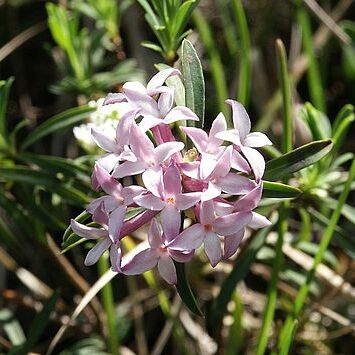Shrubs or small trees, rarely herbs, evergreen or deciduous. Bark tough and fibrous. Leaves opposite or alternate, rarely some ternate, estipulate; blade simple, entire, pinnately veined, articulate at base. Plants mostly bisexual, sometimes dioecious. Inflorescences terminal or subterminal, less often axillary, sometimes on brachyblasts, sessile or pedunculate, basically racemose, sometimes capitate, spicate, umbelliform, or fascicled. Flowers usually actinomorphic, bisexual or unisexual (plants then mostly dioecious), bracteate (sometimes bracts forming an involucre) or ebracteate, sessile or pedicellate. Calyx tubular, campanulate, or infundibuliform, usually corollalike, 4-or 5(or 6)-merous, mostly caducous, sometimes circumscissile, or persistent; lobes imbricate. Petals absent or represented by 4-12 scales, inserted at or near throat of calyx tube (Aquilaria). Stamens 2 to many, usually as many as calyx lobes and opposite them or twice as many. Hypognous disk usually present at base of ovary, scalelike, annular or cup-shaped, sometimes absent. Ovary superior, 1-or 2-loculed, sessile or shortly stipitate; ovules solitary in each locule, pendulous, anatropous; style filiform, caducous, sometimes very short or obscure, terminal or eccentric; stigma capitate, globose, subglobose, subclavate, or pyramidal, sometimes papilose. Fruit mostly indehiscent, dry or fleshy, sometimes a loculicidal capsule (Aquilaria). Seeds with or without endosperm, embryo straight.
Annual herbs to trees, usually shrubs, commonly with stringy bark, often with simple hairs. Leaves simple, entire, usually reticulate-veined; stipules absent or vestigial. Inflorescence commonly racemose or spicate to capitate. Flowers actinomorphic or rarely slightly zygomorphic, usually with a well-developed corolla-like hypanthium. Calyx of 4 or 5 or sometimes 3 or 6 sepals or lobes or rarely (not in Australia) erose, arising at summit of hypanthium or sometimes basal. Corolla lobes (when present) as many as or more than sepals, often scale-like, inserted at throat of hypanthium or sometimes free from other floral whorls. Stamens 1–80, usually 2–10, inserted on hypanthium or sometimes free, often in 2 whorls; anther locules 2, parallel, longitudinally dehiscent. Nectary disc or glands often present around base of ovary. Ovary free, superior, 2–12-carpellate, 1–12-locular; ovules 1 per carpel, pendulous; style simple. Fruit indehiscent or sometimes a loculicidal capsule. Embryo oily, straight.
Herbs or shrubs, deciduous or evergreen. Stems flexible; wood usually poorly lignified; bark ring; disc usually present (minute or absent in Thymelaea), surrounding gynoecium; stamens usually diplostemonous; anthers introrse, 4-sporangiate; ovary 1-locular, 1(–5)-carpellate; ovules 1+, pendent, raphe ventral, bitegmic, arillate or carunculate, anatropous or hemianatropous, crassinucellate; style 1, rarely absent, terminal or lateral; stigma capitate, clavate, or punctiform. Fruits capsular or drupaceous, usually fleshy, rarely dry, indehiscent [dehiscent]. Seeds 1[–8], usually with endosperm, testate; cotyledons 2, embryo achlorophyllous.
Stamens as many or twice as many as the calyx lobes (rarely reduced to 2 or 1), in 1–2 whorls, those of the upper whorl opposite the calyx lobes; anthers with filaments or sessile, 2-thecous, usually introrse, rarely extrorse, or horseshoe-like, opening lengthwise by slits; pollen grains globose, usually polyporate with ‘Croton pattern’
Leaves alternate or opposite, sometimes whorled, sessile or shortly petiolate, simple, entire, small needle-like and 1-nerved to large flat and pinnately nerved, without stipules, herbaceous or coriaceous, sometimes glandular punctate
Ovary superior, 1–2(rarely 4–12)-locular, sessile or shortly stipitate; ovules 1 per locule, usually pendulous, anatropous; style filiform, sometimes very short, terminal or lateral; stigma usually capitate, sometimes papillate
Petals generally inserted in the throat of the calyx tube, equalling or double the number of calyx lobes, well developed, entire or divided, sometimes ciliate, often reduced to small fleshy glands or lacking
Calyx tubular or funnel-shaped, sometimes articulated above the ovary, usually coloured, often petal-like; lobes (3)4–5(6), usually imbricate, equal or often with the two interior slightly smaller
Seed usually with a caruncle-like appendage, outer coat thin or crustaceous, usually black, with or without endosperm; embryo straight; cotyledons flat or thickened, narrow or broad
Inflorescences terminal or axillary, sessile or pedunculate, racemose (spikes, fascicles, umbels or heads), rarely 1-flowered, often with deciduous or persistent bracts
Disk hypogynous, membranous or fleshy, annular, cupular or scale-like, sometimes slightly crenate, now and then minute or lacking
Fruit often a berry, sometimes a nut, drupe or loculicidal capsule, usually enclosed in the base of the persistent calyx tube
Stamens as many or twice as many as the calyx-lobes, inserted in the calyx-tube; anthers 2-celled, opening lengthwise
Trees or shrubs, sometimes lianes, rarely perennial herbs, very rarely annuals, sometimes dioecious or polygamous
Trees, shrubs or rarely herbs; leaves opposite or alternate, entire, often small and ericoid; stipules absent
Flowers hermaphrodite or unisexual, regular or rarely slightly irregular, sweetly scented at night
Ovary superior, 1–2-celled; ovule solitary in each cell, pendulous; style simple; stigma entire
Petals present or absent, sometimes very small, mostly inserted at the mouth of the calyx-tube
Calyx tubular, more or less cylindric, sometimes long and slender; lobes 4–5, imbricate
Fruit a nut, drupe or pyrene, usually enclosed in the base of the calyx-tube
Flowers actinomorphic, usually hermaphrodite, sometimes capitulate
Stems and branches with tough cortical, often shiny fibres
Seeds with or without endosperm; embryo straight
Disk hypogynous or absent

